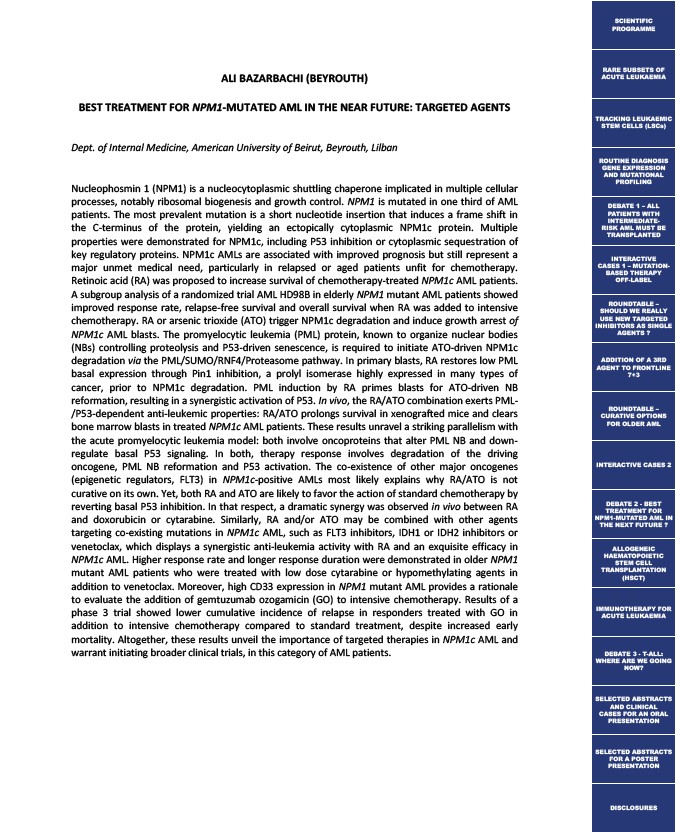
ALI BAZARBACHI (BEYROUTH)
BEST TREATMENT FOR NPM1-MUTATED AML IN THE NEAR FUTURE: TARGETED AGENTS
Dept. of Internal Medicine, American University of Beirut, Beyrouth, Lilban
Nucleophosmin 1 (NPM1) is a nucleocytoplasmic shuttling chaperone implicated in multiple cellular
processes, notably ribosomal biogenesis and growth control. NPM1 is mutated in one third of AML
patients. The most prevalent mutation is a short nucleotide insertion that induces a frame shift in
the C-terminus of the protein, yielding an ectopically cytoplasmic NPM1c protein. Multiple
properties were demonstrated for NPM1c, including P53 inhibition or cytoplasmic sequestration of
key regulatory proteins. NPM1c AMLs are associated with improved prognosis but still represent a
major unmet medical need, particularly in relapsed or aged patients unfit for chemotherapy.
Retinoic acid (RA) was proposed to increase survival of chemotherapy-treated NPM1c AML patients.
A subgroup analysis of a randomized trial AML HD98B in elderly NPM1 mutant AML patients showed
improved response rate, relapse-free survival and overall survival when RA was added to intensive
chemotherapy. RA or arsenic trioxide (ATO) trigger NPM1c degradation and induce growth arrest of
NPM1c AML blasts. The promyelocytic leukemia (PML) protein, known to organize nuclear bodies
(NBs) controlling proteolysis and P53-driven senescence, is required to initiate ATO-driven NPM1c
degradation via the PML/SUMO/RNF4/Proteasome pathway. In primary blasts, RA restores low PML
basal expression through Pin1 inhibition, a prolyl isomerase highly expressed in many types of
cancer, prior to NPM1c degradation. PML induction by RA primes blasts for ATO-driven NB
reformation, resulting in a synergistic activation of P53. In vivo, the RA/ATO combination exerts PML-
/P53-dependent anti-leukemic properties: RA/ATO prolongs survival in xenografted mice and clears
bone marrow blasts in treated NPM1c AML patients. These results unravel a striking parallelism with
the acute promyelocytic leukemia model: both involve oncoproteins that alter PML NB and down-regulate
basal P53 signaling. In both, therapy response involves degradation of the driving
oncogene, PML NB reformation and P53 activation. The co-existence of other major oncogenes
(epigenetic regulators, FLT3) in NPM1c-positive AMLs most likely explains why RA/ATO is not
curative on its own. Yet, both RA and ATO are likely to favor the action of standard chemotherapy by
reverting basal P53 inhibition. In that respect, a dramatic synergy was observed in vivo between RA
and doxorubicin or cytarabine. Similarly, RA and/or ATO may be combined with other agents
targeting co-existing mutations in NPM1c AML, such as FLT3 inhibitors, IDH1 or IDH2 inhibitors or
venetoclax, which displays a synergistic anti-leukemia activity with RA and an exquisite efficacy in
NPM1c AML. Higher response rate and longer response duration were demonstrated in older NPM1
mutant AML patients who were treated with low dose cytarabine or hypomethylating agents in
addition to venetoclax. Moreover, high CD33 expression in NPM1 mutant AML provides a rationale
to evaluate the addition of gemtuzumab ozogamicin (GO) to intensive chemotherapy. Results of a
phase 3 trial showed lower cumulative incidence of relapse in responders treated with GO in
addition to intensive chemotherapy compared to standard treatment, despite increased early
mortality. Altogether, these results unveil the importance of targeted therapies in NPM1c AML and
warrant initiating broader clinical trials, in this category of AML patients.
SCIENTIFIC
PROGRAMME
RARE SUBSETS OF
ACUTE LEUKAEMIA
TRACKING LEUKAEMIC
STEM CELLS (LSCs)
ROUTINE DIAGNOSIS
GENE EXPRESSION
AND MUTATIONAL
PROFILING
DEBATE 1 – ALL
PATIENTS WITH
INTERMEDIATE-RISK
AML MUST BE
TRANSPLANTED
INTERACTIVE
CASES 1 – MUTATION-BASED
THERAPY
OFF-LABEL
ROUNDTABLE –
SHOULD WE REALLY
USE NEW TARGETED
INHIBITORS AS SINGLE
AGENTS ?
ADDITION OF A 3RD
AGENT TO FRONTLINE
7+3
ROUNDTABLE –
CURATIVE OPTIONS
FOR OLDER AML
INTERACTIVE CASES 2
DEBATE 2 - BEST
TREATMENT FOR
NPM1-MUTATED AML IN
THE NEXT FUTURE ?
ALLOGENEIC
HAEMATOPOIETIC
STEM CELL
TRANSPLANTATION
(HSCT)
IMMUNOTHERAPY FOR
ACUTE LEUKAEMIA
DEBATE 3 - T-ALL:
WHERE ARE WE GOING
NOW?
SELECTED ABSTRACTS
AND CLINICAL
CASES FOR AN ORAL
PRESENTATION
SELECTED ABSTRACTS
FOR A POSTER
PRESENTATION
DISCLOSURES